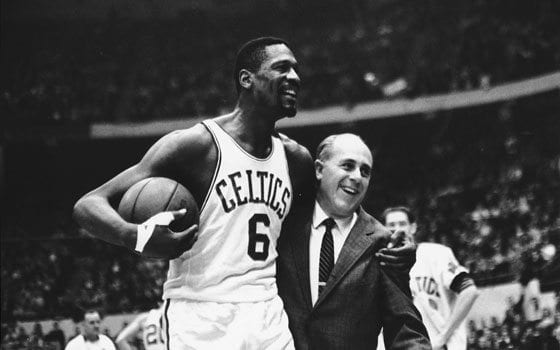

Bill Russell was a rare breed, on and off the court
Today, community activism seems to be at a low ebb in Boston and community involvement by sports heroes is too often confined to much-appreciated but well-publicized charity golf tournaments and visits to schools and hospitals.
It may be useful, then, to recall an earlier time in the city’s history — almost 50 years ago — when activism was (pun intended) all the rage and one of the city’s greatest athletes got involved in its civic life not to enhance his “image” but because he felt it was the right thing to do.
Boston was a different city back then. As the Rev. Martin Luther King Jr. said on Boston Common after leading the “March on Boston” in April 1965: “It would be dishonest to say Boston is Birmingham, but it would be irresponsible for me to deny the crippling poverty and the injustices that exist in some sections of this community.” Then Dr. King added: “The vision of the New Boston must extend into the heart of Roxbury. Boston must become a testing ground for the ideals of freedom.”
Bill Russell had already taken it upon himself to help make it one. Three years before, in May 1963, Russell had led a contingent of 2,000 marchers from Roxbury that joined 8,000 others on Boston Common. It was the largest civil rights demonstration in Boston history up until that time, and it was held to support Dr. King’s work in Birmingham.
Julian Houston, then a Boston University student and later a Massachusetts Superior Court judge, explained why he was there that day. “People saw fire hoses knocking down children on the nightly news,” he later recalled. “And they said: ‘Wait a minute! We can’t put up with that! We’ve got to do something about this.”
Russell was one of those people. Russell was also there a month later, in June 1963, when 5,000 African American junior and senior high school students staged the first “Boston School Stay Out” to protest “de facto segregation” in the Boston Public Schools. The students didn’t just boycott their classes, though, they attended “Freedom Schools.”
The schools were created by community activists like Noel Day and Rev. James Breeden, and the teachers were volunteers using a “civil rights curriculum” they had created that would later be used in Mississippi. The students also listened to guest speakers. Among those speakers were the Rev. Anson Phelps, Episcopal Bishop of Massachusetts, and a Mr. William Fenton Russell.
Three years later, in June 1966, Russell was the graduation speaker at a “Freedom Graduation Ceremony” at St. Hugh’s church for students at the Patrick Campbell Middle School. The original ceremony had been interrupted when Rev. Virgil Wood, Massachusetts chairman of the Southern Christian Leadership Council in Boston, led a protest against the presence of Boston School Committee woman Louise Day Hicks, whose refusal to take the small steps needed to address segregation in the schools in the 1960s led a federal judge to order more drastic steps to be taken in the 1970s.
Ruth Batson led the fight to desegregate Boston’s schools and she was at the Campbell graduation ceremony. After Russell’s speech, she later wrote, he “proceeded to give each student his autograph [even though] it was well known that Mr. Russell did not give autographs.”
Batson also wrote that, when he noticed the “please will you?” look on her face, he gave her one, too — writing: “God bless you, Ruth,” on a sheet of paper she had been holding in her hand. Two years after that, in April 1968, Russell was there again when demonstrators protesting that urban renewal meant “Negro removal” erected a “Tent City” in Copley Square. For four days and three nights, the demonstrators occupied the site, and Russell helped to sustain both their beliefs and their bellies by sending over soul food from Slades, the restaurant he owned on Tremont Street.
Today the site that those demonstrators occupied is home to the Tent City housing development that includes 200 units of affordable housing and a technology center where young people from the neighborhood can learn the skills needed for the jobs of today and tomorrow.
Boston is a different city today than it was 50 years ago — a better, more diverse and a more just city. There is, of course, still plenty of room for improvement. But the improvements that have been made didn’t just happen by accident. Thanks should go to all those community activists for the work they did, including one who was also an athlete and played a little basketball during the time we were lucky to have him here with us.
Jim Vrabel is the author of “When In Boston: A Time Line and Almanac.” He is now working on a book about community activism in Boston in the 1960s.






